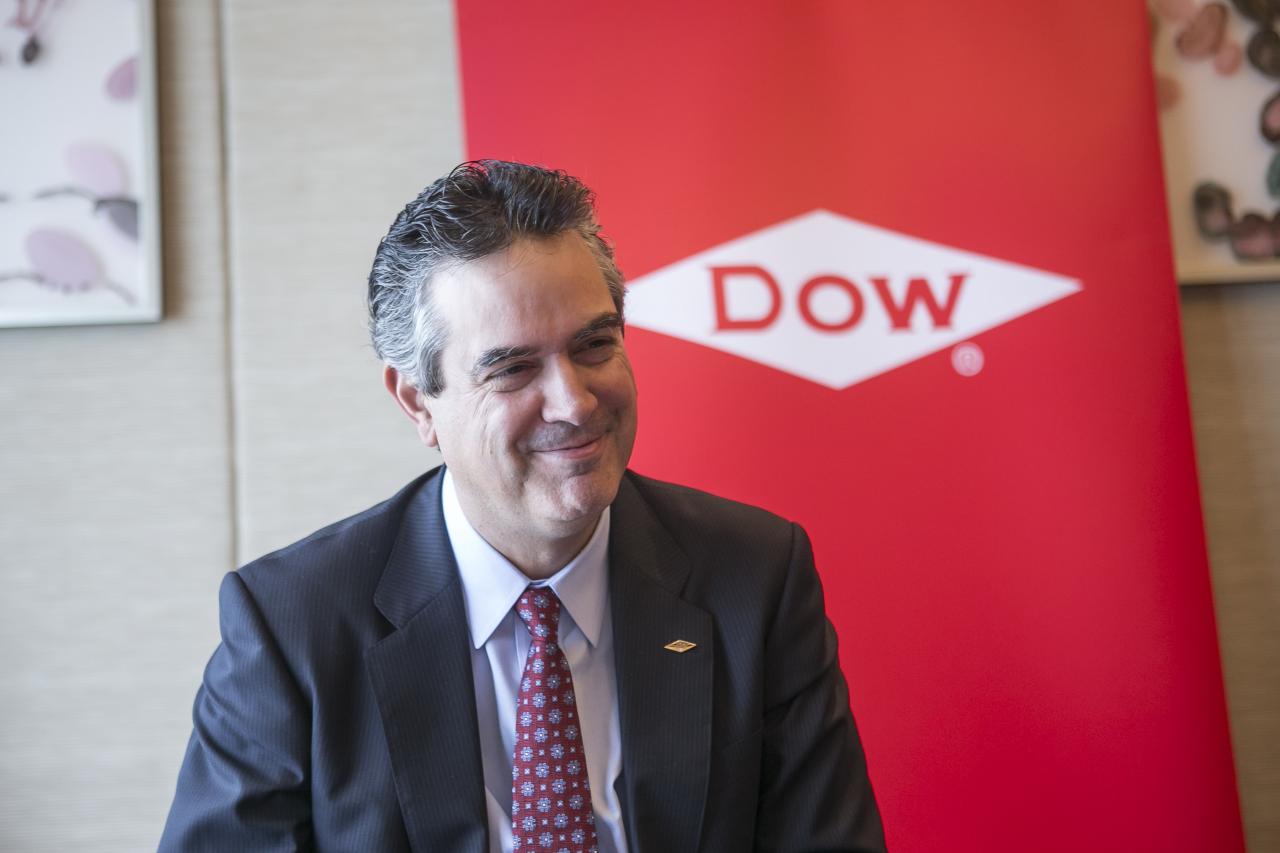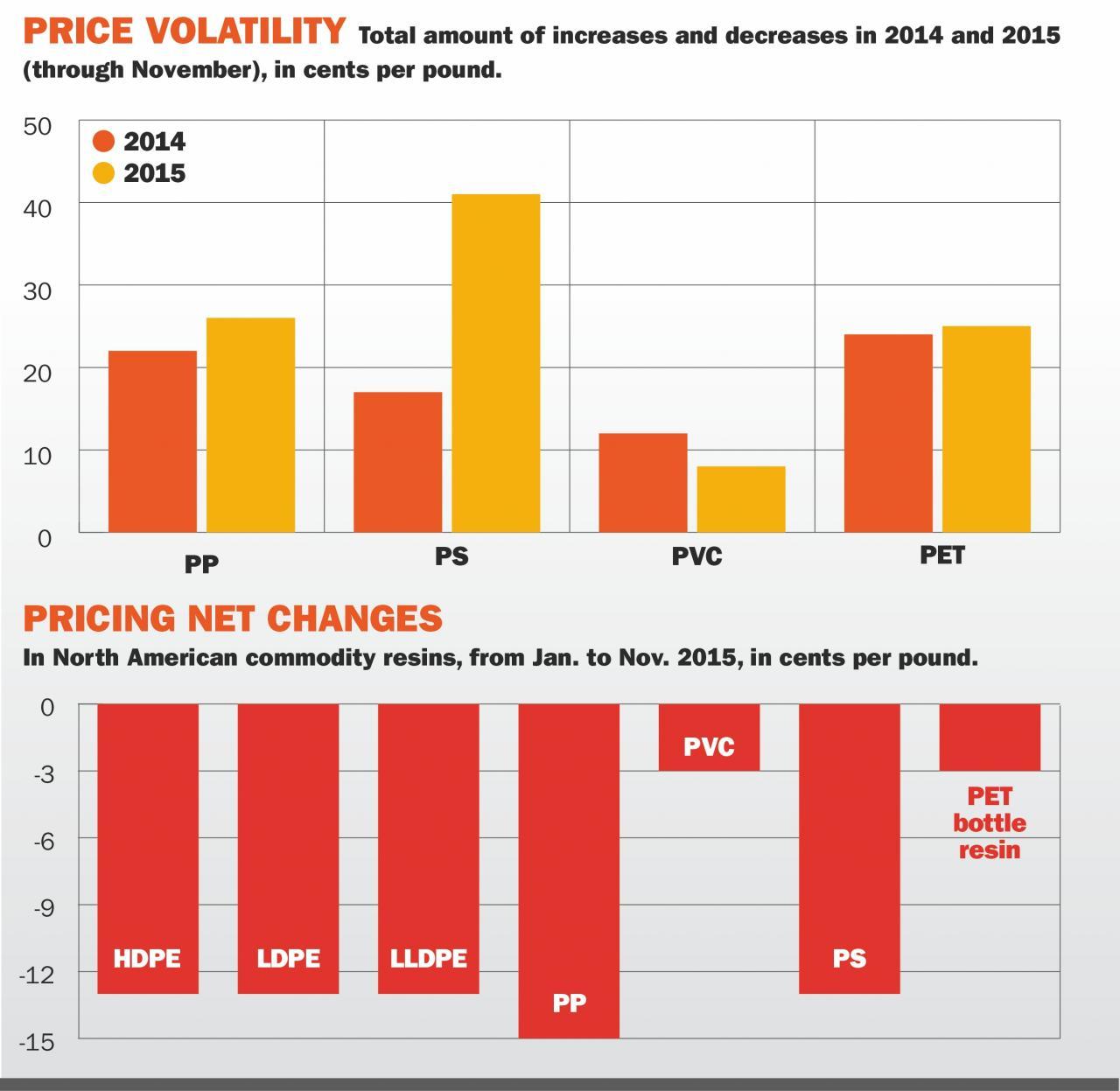December 28, 2015 Updated 12/28/2015
Email Print

Dow Chemical Co. Donoso
For the North American polyethylene resin market, 2016 might prove to be the calm before the storm.
Three new capacity projects are set to come on line that could add as much as 4 billion pounds of production capacity to the market next year. Similar projects expected in 2017 could boost capacity by another 6 billion pounds.
Overall, 27 PE expansions have been announced for North America. If they all come to fruition, they’ll add more than 34 billion pounds of capacity — a 75 percent jump over current capacity of roughly 45 billion pounds.
This scenario has led to some concern. The domestic PE market is growing, but not at a rate high enough to handle that much material. That means a good chunk of that new PE will have to be exported outside North America.
For his part, Dow Chemical Co. executive Diego Donoso believes the PE market will be able to handle the new capacity, which is being made possible through low-priced feedstocks based on shale gas.
“You have to look at the impact of the world, because it’s all connected,” said Donoso, global packaging and specialty plastics business president with Midland, Mich.-based Dow. “And before you look at 2016, you need to look at 2013 and 2014 when we had a high oil price scenario. The market added [13 billion pounds] of new capacity globally and was able to absorb it. We had 20 cents in [PE price] increases without a single price drop, and the market stabilized because supply was tight.
“Then in 2015,” he added, “lower oil prices took the floor away and there were price corrections and an overcorrection of inventory. It was a very different world than in 2013 and 2014, but we didn’t give away all of our margin to the market.”
Chris Bezaire of PE maker Nova Chemicals Corp. also believes that those expecting chaos from the new PE capacity will be disappointed.
“There’s no question there will be a [PE] surplus, but it will be fleeting,” said Bezaire, PE vice president with Calgary, Alberta-based Nova. “We’ll work with that. We’re not afraid.”
“Between now and 2020-21, new supply add will find its way into the marketplace,” he added. “Not all of it will be in North America. A new supply/demand equilibrium will come into line and there might be a short-time 10 percent surge in exports. It’s natural ebb and flow.”
But Donoso and Bezaire might need to spend some more time convincing veteran industry consultant Robert Bauman that all will be well with the market once the new PE arrives.
“It’s going to be a bloodbath,” said Bauman, president of Polymer Consulting International in Spring, Texas. “We’re going to see inventory build with prices dropping. It will be one of the worst performance periods for the industry in a long time.”

Bauman added that PE export markets “don’t have a panacea in Latin America — the economy in Brazil is a disaster and Argentina isn’t good.”
Market analyst Mike Burns was taking a calmer approach to the PE situation at Resin Technology Inc. in Fort Worth, Texas.
“To keep a good balance [in North America], we have to compete with the global price,” Burns said. “As long as the North American price is within 10 cents of the Asia price, that will keep Asian resin from getting into the U.S. and will allow the U.S. to export to Latin America.
“We have to keep that balance of exports flowing and stopping imports from coming in. If our price gets too high outside that window, North American processors would call China,” Burns added. “The key to the whole thing is the price of oil and the cost to make pellets in other regions.”
2016 “is looking to be a transition year to the long awaited PE buyer’s market that should be fully in place during 2017 and 2018,” said Phil Karig, managing director of the Mathelin Bay Associates LLC consulting firm in St. Louis. 2016 PE demand growth “should be tepid at best,” he added, and PE exports from the U.S. to Mexico “will have to find another home as the massive Braskem PE joint venture comes on line.”
Profit margins for North American PE makers should still be “quite good” in 2016, according to market analyst David Barry at PetroChem Wire LLC in Houston. Producers “aren’t worried about margin in the near term,” he added. “But that will change when the new capacity comes on.”
Barry described the export market as “a wild card,” but he added that North American exports recently had some strong months at times when exports traditionally hadn’t been that strong.
Through October, U.S./Canadian sales of high density PE were up 6.6 percent, according to the American Chemistry Council in Washington. Domestic sales were up only 1 percent for the period, but export sales rocketed up almost 42 percent. Sales of HDPE into household chemical bottles provided a domestic bright spot, growing 7 percent.
Regional sales of low density PE through October improved 3.3 percent, with domestic growth of almost 4 percent lessened somewhat by growth of only 1.2 percent in export markets. Sales of LDPE into non-food packaging film soared more than 11 percent in that 10-month period.
For linear low density PE, 10-month sales grew 6.3 percent. Domestic sales growth of almost 6 percent was amplified by a 9 percent rise in export sales. Sales of LLDPE into all types of film — packaging and non-packaging — climbed almost 8 percent in that period.
Donoso recently met with several large food packaging companies who were moving more products into ready-to-eat snack packaging. “Even more food companies are going from rigid packaging to flexible,” he said.
“Packaging is strong,” added Bezaire at Nova. “More people are more eating out of the home. Families are smaller and they eat out more than we did as kids.”
Nova will do its part for new PE capacity with a 1 billion pound-capacity LLDPE line in Joffre, Alberta. Mechanical completion of the line is set for July 1, Bezaire said, with material expected to be available in the market in September and October.
The new line’s output “is an extension of what we currently produce,” he said. “We’re building what our customers want.” Nova also is considering building a new PE plant either in Ontario or on the U.S. Gulf Coast, Bezaire added.
North American PE demand also will be helped by new capacity making better-quality resins in volumes that previously were unavailable, he said. This will allow North American processors to make products that couldn’t be made with earlier resins.
“The PE being made in Joffre is the cleanest PE in North America when it comes to gels and clarity,” he said. “The future is bright — it’s maybe never been brighter in North America.”
Dow’s Donoso agreed that the quality of PE being made in North America has greatly improved. “All of our reactors are providing our highest-performing products,” he said. “To go from rigid to flexible packaging, you need better resins.”
He added that he’s doubtful that all of the PE capacity projects announced for North America will come online as scheduled, pointing out that previous waves of capacity expansion often had delays. Bauman agreed, saying welders, pipefitters and other specialty workers needed to build these new lines and plants are becoming scarce on the Gulf Coast.
Through October, PE makers in the U.S. and Canada were exporting about 21 percent of total LDPE and LLDPE production and about 18 percent of their HDPE output. RTI’s Burns and other market watchers say those numbers need to be closer to 30-35 percent to handle the new capacity.
“If you’re a [PE] seller, you’re going to see increased competition, more capacity chasing demand and price and margin pressure,” IHS Chemical analyst Nick Vafiadis said in October at the Global Plastics Summit 2015. “If you’re a buyer, you’re going to see more supply options, increased competition and increased quality demands.”
“The [North American PE] market is going to be very competitive in two to three years,” added Barry at PetroChem Wire. “Producers will need to cater to processors to get material sold. If they don’t, someone else will.”
Mathelin Bay’s Karig doesn’t see the new capacity affecting regional PE prices much in 2016. “Even with reduced exports, capacity utilization in 2016 will remain high enough to keep PE prices from cratering, unless oil prices turn sharply downward again,” he said.
At Dow, Donoso remains confident.
“The world will balance itself,” he said. “The market is very resilient.”



























